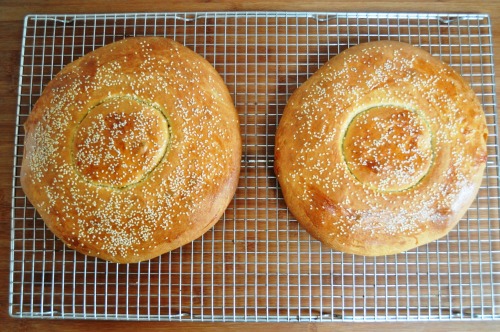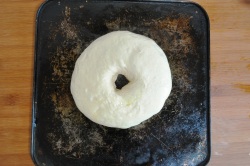A week ago I did a post for a bread recipe I had in an old 1994 notebook called Los Angeles peda bread. It was accompanied by another recipe simply called Armenian peda bread. The former, I subsequently discovered, is probably a version of Armenian flatbread called matnakash. This Armenian peda (their word related to pide and pita), meanwhile, is another minor mystery, with the source of the recipe I wrote down back in 1994 unknown. Similar breads can be seen online, but I’m afraid I can’t find a more specific Armenian name for it.*
Ignorance notwithstanding, like the LA peda, this is another great sharing bread, perfect for tearing up at a family gathering – like we did over the weekend with sister-in-law Sharon, niece and nephew.
As with the LA peda, this version is basically just a conversion and slight update of the one I had in my notebook. I did reduce the yeast slightly, but again, if I revise it further, I’ll reduce it more and do a longer fermentation.
Makes two large round loaves
10g active dried yeast, or 30g fresh yeast
120g water
430g milk
20g caster sugar
6g salt
780g strong white bread flour
50g olive oil
extra olive oil
1 egg
sesame seeds
1. Combine the water and milk and warm to about blood temperature. You can adjust the quantities of milk and water if you want, to make up 550g of liquid. More milk makes for a sweeter, richer bread.
2. Stir in the sugar, then add the yeast, crumbling it if you’re using fresh. Give it a whisk.
3. In a large bowl, combine the salt and flour.
4. When the yeast is starting to froth, add to the flour, along with the 50g olive oil.


5. Bring the dough together, turn out and knead until smooth. Alternatively, do it in a mixer with a dough paddle. Add a splash more water if the dough feels dry.
6. Form the dough into a ball then put the bowl (cleaned) with a splosh of olive oil and cover with a cloth.

7. Leave to prove until doubled in size. Time will vary depending on your room temperature etc but around an hour or two at about 18-20C.
8. When it’s doubled in size, divide it into two equal portions. Mine weighed 1420g, so each portion was more or less 710g.


9. Cut a piece weighing about 140g off each portion, then form all the pieces into balls.
10. Cover with a damp cloth and leave to rest for about 15 minutes.
11. Take the larger balls and put them on lightly oiled baking sheets.


12. Flatten the balls out slightly, then poke through finger through the middle. Open this hole out to about 10cm. This is fun. If you’re confident, you can lift up the dough ring and stretch it in the air.
13. Take the smaller balls and put them into these holes, flattening slightly.

14. Brush with olive oil then leave to prove again, until doubled in size. Cover with a damp cloth or plastic. Or you could leave them in the fridge, wrapped in plastic, overnight.
15. Preheat the oven to 180C.


16. Beat an egg, or an egg yolk with 1 tbsp milk, and glaze the breads. Sprinkle with sesame seeds.
17. Bake for about 40 minutes. If they’re browning too much, turn down the heat and/or cover the tops with foil.
18. If your oven doesn’t have much botton heat, you can take them out, take them off the baking sheets and put them back in for another 5-10 minutes.

19. Remove and allow to cool on racks.
Enjoy. Perhaps with some dips. As with the LA peda bread, I’ve been eating mine with a hummus-substitute made with English grown pulses from Hodmedod’s. I used split dried fava and wild garlic. So much wild garlic at the moment. I love the stuff, but it is a tad pungent, especially when it’s included in every meal for several days running…
* This peda is not unlike another Armenian bread called choereg or choreg, which is a relative of challah, but made for the Orthodox Christian Easter. Like challah, it’s formed in a braid, though apparently it’s made distinctive by an ingredient called mahlep/mahlab – a flavouring or spice made from the ground stones of the Mahaleb cherry that isn’t what you’d call commonplace in England.





Reblogged this on CreativelyShared.
Please update the recipe converting the measurements from grams to US equivalent, i.e. ounces, cups, etc. Thanks!
I don’t use cups or other old-fashioned measurements. It’s easy to convert from grams to ounces, plenty of tools online but for serious baking, I’d recommend getting some electronic scales and using grams. So much easier once you get used to it.
Thank you for the basis of peda bread!! We’ve loved it for years while living in Fresno (35!), & recently shared it with a friend, who’d never heard of it, but really liked it after trying one time. It freezes well, too. ❤️❤️👏👏
Great. Glad it hits the spot. Have you tried the Los Angelese peda bread recipe too? I like them both but possibly prefer the “LA” one more. https://breadcakesandale.com/2015/03/20/los-angeles-peda-bread-a-version-of-armenian-matnakash/
If using a mixer and dough hook, how long would you let it run? After 5-6mins, the dough was pretty crumbly (low 61.5% hydration compared to the rye/sourdough I’m used too – novice at yeast breads). I kneaded for another 10 or so minutes and even added ~1Tbs of water to get the dough to stick to itself. I couldn’t get it to get “smooth” (nowhere near your photo in the fermenting bowl). At some point, when folded, the dough stopped sticking to itself. Instead of adding even _more_ water, I set it in my bowl to double in volume. It looks like a drying brain with folds all around the surface. Should I let it rest or add water then knead more?
Ah, sounds tricky. Even with all the milk, water and olive oil? Too dry, I’d defo add more liquid. I do find some flours much more absorbant than others. Mine does look like quite a well hydrated dough in the pics. I’ve not made it for a while. Will have to try it again and report back. Also, as milk is only around 87% water, it’s potentially as little as 55% hydration (400g milk = about 348g water + 80g water = 428g water to 780g flour).
I’ve gone back to my original notepad and changed the quantities here a bit. Added 50g more liquid.